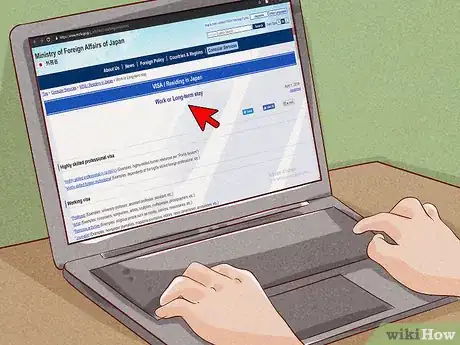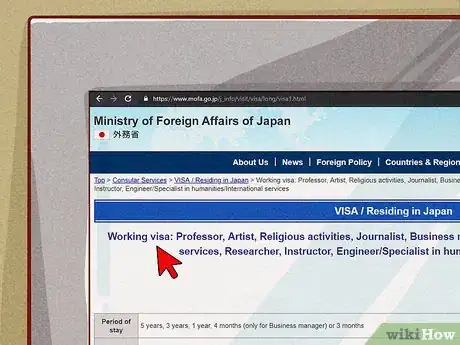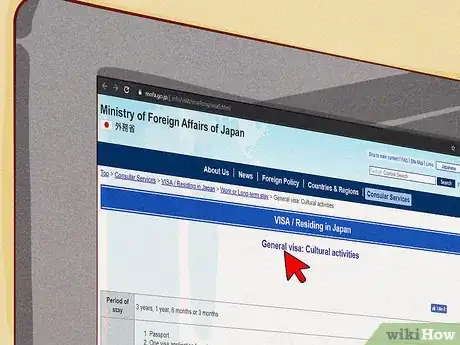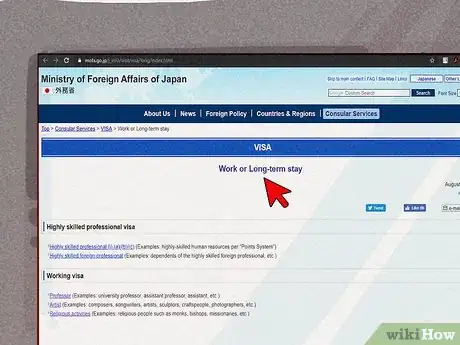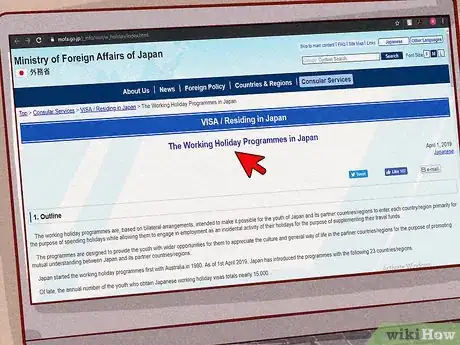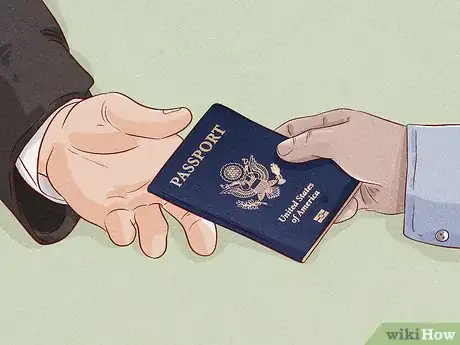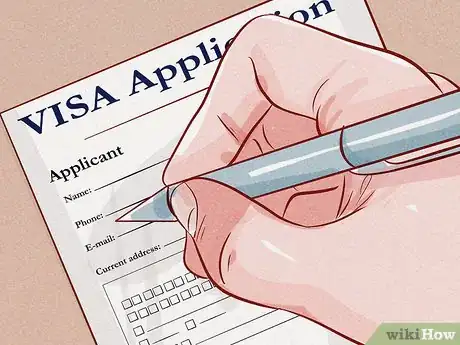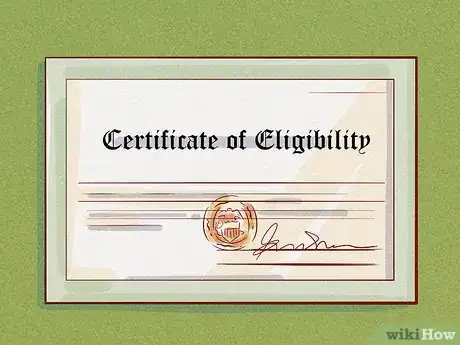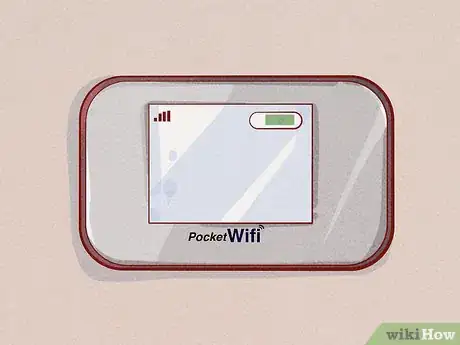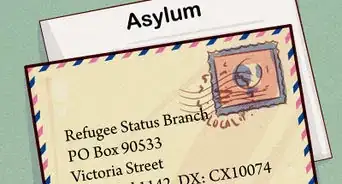This article was co-authored by wikiHow Staff. Our trained team of editors and researchers validate articles for accuracy and comprehensiveness. wikiHow's Content Management Team carefully monitors the work from our editorial staff to ensure that each article is backed by trusted research and meets our high quality standards.
There are 12 references cited in this article, which can be found at the bottom of the page.
This article has been viewed 15,070 times.
Learn more...
There are many reasons to move to Japan. Maybe you love anime and manga. Maybe you're longing to stroll through blooming cherry blossoms, or taste delicious fresh sushi. Whatever your motivation, you can achieve your dream by researching your visa options, assembling the necessary documents, and preparing to move. Once you're in Japan, settle in and let this new chapter of your life begin!
Steps
Researching Visa Options
-
1Choose the visa that is right for your needs. Consider how long you are intending to stay in Japan and what you will be doing while you are there. Are you a college student? Will you be pursuing art? Will you be teaching English? Are you married to a Japanese citizen? These different factors will determine which visa is right for you.
- Go to https://www.mofa.go.jp/j_info/visit/visa/long/index.html to look at the list of working and long-term visa schemes available. Click on the link to schemes you think apply to you to learn more.
-
2Apply for a working visa if you plan to work. If you have a bachelor’s degree and speak English, the most common way to work in Japan is to teach English. Many education companies in Japan hire English-speaking foreigners on one or two year contracts. You would then apply for a visa as a Specialist in Humanities/Instructor.[1]Advertisement
-
3Apply for a general visa if you are a student or pursuing cultural activities. Cultural activities could include an unpaid internship or studying some aspect of Japanese culture, such as martial arts.[4]
- Consult the website of your home country's Japanese embassy for more information about visa regulations.
-
4Apply for a specified visa if you are the spouse or child of a Japanese national. A specified visa will also work for the spouse of a permanent resident or long-term resident.[5] You can find more information to see if you might qualify at the website of the Ministry of Foreign Affairs of Japan https://www.mofa.go.jp/j_info/visit/visa/long/index.html.
-
5Consider a tourist or working holiday visa. Some people take the chance of applying for a tourist visa, to stay for 90 days, and then reapplying for long-term residency after arrival. However, this has the risk of not getting renewed. Similarly, you could get a working holiday visa, if you come from an eligible country. A working holiday visa allows you to stay for six months and then renew.[6]
- Countries eligible for a working holiday visa to Japan: Australia, New Zealand, Canada, Republic of Korea, France, Germany, The United Kingdom, Ireland, Denmark, Taiwan, Hong Kong, Norway, Portugal, and Poland.[7]
Gathering Necessary Documents
-
1Obtain a passport if you do not have one already. Go to your local passport agency. You can look up online where your nearest passport agency is. Call ahead to research what documents you will need to be. If you are in the US, you will need to bring Form DS-11, proof of U.S. citizenship, a government issued photo ID, a color passport photo, and fee payment. [8]
- Processing a passport request can take up to 8 weeks. If you are leaving before then, you can get expedited service for 2-3 weeks, for a fee. [9]
-
2Fill out a visa application form. You will need to fill out a different form depending on which kind of visa you’ve decided to apply for. [10] You can find more information about how to get the visa form by going to the website of your home country's Japanese embassy.
-
3
-
4Complete a Certificate of Eligibility. This certificate must prove that you will have a minimum financial support of about 180,000 yen per month during the time you plan to stay in Japan. [13]
Preparing to Move
-
1Choose a city to live in. Most expatriates live in cities in Japan, rather than the countryside, because cities have the most employment opportunities.[14] Your job might determine which city you live in, but if you have a choice, research your options. Popular locations for expatriates include Tokyo, Yokohama, Kyoto, and Osaka.[15]
- Tokyo has the world's largest metropolitan economy. It's a huge, bustling city, and very expensive. It is home to lots of investment banks.[16] But if you have the salary, and love the excitement of huge cities, this could be the place for you!
- Yokohama is a huge port city, a center for bio-tech, pharmaceutical, IT, and electronics. It's much cheaper than Tokyo, and is home to many foreigners.[17]
- Kyoto and Osaka are home to research institutes and universities. Kyoto also has a big tourism industry, because it is such a beautiful and historic city.[18]
- Nagoya is much smaller than Tokyo, and boasts a shogun's castle. It is a port city and a hub of manufacturing, aerospace engineering, and automotive business.[19]
-
2Find temporary accommodation. Don’t worry about finding a long-term home from abroad. First arrange temporary accommodation, and then you can search for better, long-term housing, once you are actually in Japan. If you are teaching English at a conversation school, many of the sponsoring companies will help you arrange temporary housing. [20]
-
3Learn Japanese, if you don’t know it already. You don’t have to be fluent in Japanese before you move, but having some knowledge of Japanese will help you navigate, work, and make friends once you arrive. See if your local community college offers a course, or check out an online course. [23]
-
4Pack your belongings. Make sure to bring only what you need, especially if you are moving from very far away. Remember, you can buy furniture and other household items in Japan.
- If you want to bring your furniture with you, consider hiring a shipping company. Shipping your furniture will be expensive, but if you have really nice furniture, it might be worth it. Go with a large, international company, to make sure you belongings are safely delivered. [28]
Settling In
-
1Get your phone working in Japan. Wi-Fi is scarce in Japan, so you may want to purchase a Pocket Wi-Fi, a small portable Wi-Fi device. If you are going to be living in Japan for a long time, you will also need to get a Japanese phone and data contract.[29]
- Having a Japanese phone number will be essential for setting up a bank account and other tasks of settling in.
-
2Set up a Japanese bank account. Many foreign banks will let you take out money while you are in Japan, but they will charge large overseas fees. If you will be staying in Japan a long time, and earning money, it makes sense to open a Japanese bank account. [30]
- You won't be able to set up a bank account until you arrive in Japan.
- Bring with you your passport, residence card, visa, Japanese address, and Japanese phone number.[31]
-
3Register at the local city office. Within your first two living weeks in Japan, it is required to register your address at the local city office (called ward office in Tokyo). Go inside and present your residence card, and they will guide you through the process.[32]
-
4Reach out and make friends. It can be difficult for foreigners to blend into Japanese society, but with some effort, you can make friends.[33] Try reaching out to people you work with, asking them to go to karaoke. Join a sports group in your neighborhood.
- Tokyo and many other big cities have expat communities that host parties and social gatherings. The Tokyo American Club, for example, has its own building with a swimming pool and events.[34]
- Attend a party and get the phone numbers of people you enjoyed talking to.[35] With persistence you will build a social circle, and can fully enjoy your new life in Japan.
References
- ↑ https://nihongoshark.com/move-to-japan/
- ↑ https://tokyobecky.com/moving-to-japan-is-not-as-hard-as-you-think/
- ↑ https://tokyobecky.com/moving-to-japan-is-not-as-hard-as-you-think/
- ↑ https://nihongoshark.com/move-to-japan/
- ↑ https://www.mofa.go.jp/j_info/visit/visa/long/index.html
- ↑ https://tokyobecky.com/moving-to-japan-is-not-as-hard-as-you-think/
- ↑ https://tokyobecky.com/moving-to-japan-is-not-as-hard-as-you-think/
- ↑ https://www.usa.gov/passport
- ↑ https://www.usa.gov/passport
- ↑ https://nihongoshark.com/move-to-japan/
- ↑ https://nihongoshark.com/move-to-japan/
- ↑ https://www.usa.gov/passport
- ↑ https://nihongoshark.com/move-to-japan/
- ↑ https://www.internations.org/go/moving-to-japan
- ↑ https://www.internations.org/go/moving-to-japan
- ↑ https://www.internations.org/go/moving-to-japan
- ↑ https://www.internations.org/go/moving-to-japan
- ↑ https://www.internations.org/go/moving-to-japan
- ↑ https://www.internations.org/go/moving-to-japan
- ↑ https://nihongoshark.com/move-to-japan/
- ↑ https://nihongoshark.com/move-to-japan/
- ↑ https://www.oakhouse.jp/eng/sharehouse/about
- ↑ https://nihongoshark.com/best-way-to-learn-japanese/
- ↑ https://www.iwillteachyoualanguage.com/learn/japanese/japanese-tips/basic-japanese-phrases
- ↑ https://www.iwillteachyoualanguage.com/learn/japanese/japanese-tips/basic-japanese-phrases
- ↑ https://www.iwillteachyoualanguage.com/learn/japanese/japanese-tips/basic-japanese-phrases
- ↑ https://www.iwillteachyoualanguage.com/learn/japanese/japanese-tips/basic-japanese-phrases
- ↑ https://injapan.gaijinpot.com/uncategorized/2013/05/23/moving-your-apartment-japan/
- ↑ https://nihongoshark.com/move-to-japan/
- ↑ https://nihongoshark.com/move-to-japan/
- ↑ https://transferwise.com/gb/blog/opening-a-bank-account-in-japan
- ↑ https://nihongoshark.com/move-to-japan/
- ↑ https://www.expatolife.com/living-in-tokyo/
- ↑ https://blogs.wsj.com/expat/2015/12/29/members-only-parties-and-swimming-pools-making-friends-as-tokyo-expat/
- ↑ https://www.expatolife.com/living-in-tokyo/
